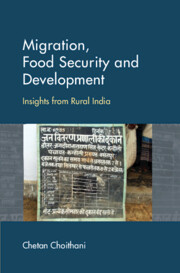Book contents
- Frontmatter
- Contents
- List of Figures, Tables and Boxes
- List of Photos
- Preface
- Acknowledgements
- List of Abbreviations
- 1 Introduction
- 2 Bridging the Disconnect between Migration and Food Security
- 3 Dynamics of Food Insecurity, Migration and Urbanisation in India
- 4 The Context of Migration
- 5 Connections between Food Safety Nets and Migration
- 6 Migration, Remittances, Land and Household Food Security
- 7 Opening the Household Box
- 8 Conclusion
- References
- Index
1 - Introduction
Published online by Cambridge University Press: 22 February 2023
- Frontmatter
- Contents
- List of Figures, Tables and Boxes
- List of Photos
- Preface
- Acknowledgements
- List of Abbreviations
- 1 Introduction
- 2 Bridging the Disconnect between Migration and Food Security
- 3 Dynamics of Food Insecurity, Migration and Urbanisation in India
- 4 The Context of Migration
- 5 Connections between Food Safety Nets and Migration
- 6 Migration, Remittances, Land and Household Food Security
- 7 Opening the Household Box
- 8 Conclusion
- References
- Index
Summary
This book examines the linkages between migration and food security in India. More specifically, it investigates the role of internal migration as a livelihood strategy in influencing food access among rural households in India. The need for this undertaking stems from a dearth of understanding of the role work-related migration plays in shaping food access among rural communities. Indeed, the relationship between migration and food security is arguably one of the most under-investigated aspects of development in contemporary India.
The larger motivation that guides this work is provided by the pressing policy need to seek insights into the mechanisms governing access to food among rural populations of India. The persistence of staggering levels of food insecurity is a major development challenge in India, and nearly 190 million people in the country suffer from chronic levels of hunger (FAO et al., 2020). The burden of chronic food insecurity is disproportionately shared by the country's rural dwellers who account for a large majority of the undernourished people. While this is the case, rural dwellers are not passive actors, and they devise multiple livelihood strategies to mitigate threats to their food security. Migration constitutes an important component of rural livelihood strategies. While migration has traditionally been an integral part of rural livelihoods in India (Tumbe, 2018), recent years have witnessed an unprecedented surge in mobility levels among the rural poor (Choithani, Van Duijne and Nijman, 2021). Thus, the question as to how rural outmigration impacts the well-being outcomes of poor households assumes greater significance. Various forms of population mobility and their impacts on source and destination communities have been extensively studied. However, despite food security being an important public policy concern, systematic knowledge on how migration can influence household food security outcomes. Most of the research thus far has invariably focused on the unidirectional relationship between the two – that is, food insecurity as a driver of distressed household migration (Mosse et al., 2002; Maharatna, 2014). Insufficient attention has been paid on the reverse causalities – that is, how migration can affect the patterns of food consumption and nutritional well-being in source regions. In large parts of India, rural outmigration commonly involves migration by relatively younger males while the other household members stay behind. This pattern of migration implies that there are several channels through which migration can have a potential bearing on household food and nutritional security.
Information
- Type
- Chapter
- Information
- Migration, Food Security and DevelopmentInsights from Rural India, pp. 1 - 26Publisher: Cambridge University PressPrint publication year: 2023
